ReD (Revue Devětsilu): modern culture monthly (1927-1931) [Czech]
Filed under magazine | Tags: · architecture, art, art theory, avant-garde, bauhaus, constructivism, czechoslovakia, dada, design, film, graphic design, literature, photography, poetry, psychoanalysis, radio, surrealism, theatre
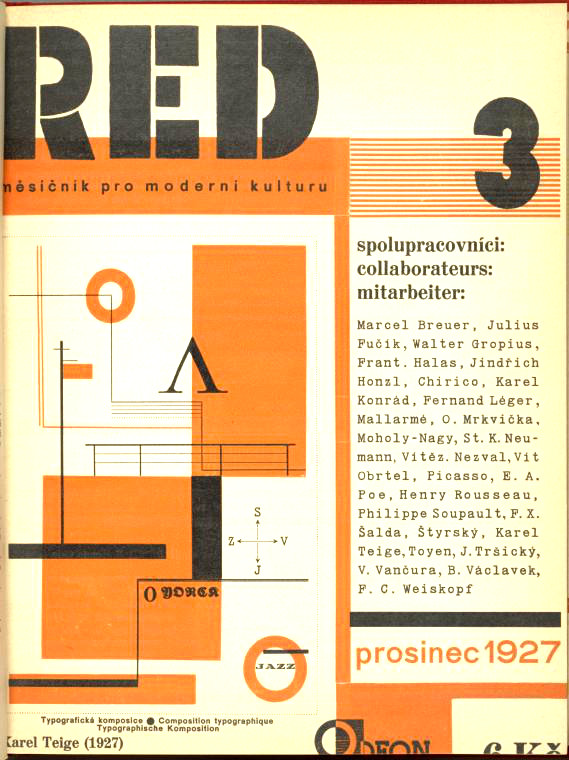
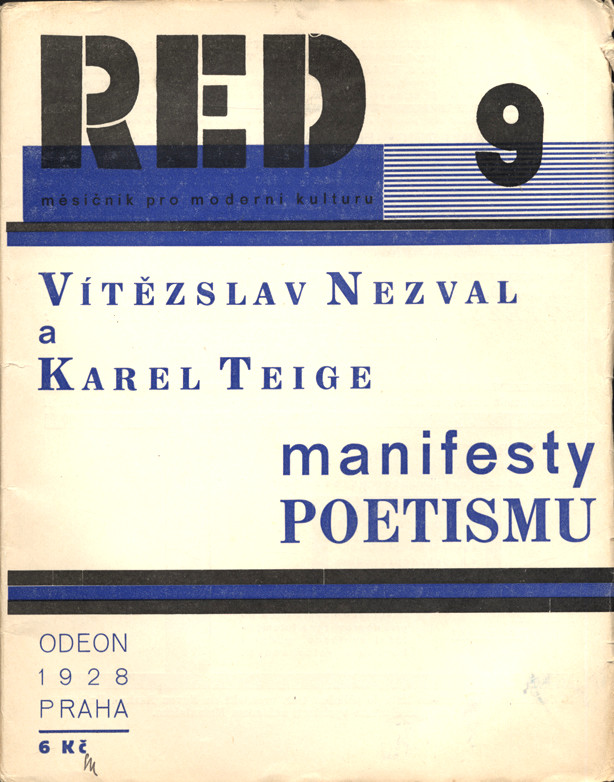
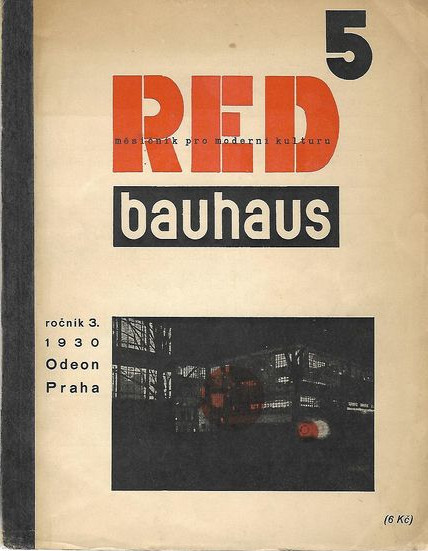
ReD (měsíčník pro moderní kulturu / Revue internationale illustrée de l’activité contemporaine / Internationale Monatsschrift für moderne Gestaltung) was an art magazine published by members of the Czech avant-garde art collective Devětsil.
Thirty numbers were published, with the special issues on the Russian avant-garde, Bauhaus, and photography/film/typography.
Several manifestos appeared in the journal: Toyen and Jindřich Štyrský’s Artificielisme (1:1, 1927), Karel Teige’s second Poetism manifesto [Manifest Poetismu] (1:9, 1928), and the Left Front [Levá fronta]’s founding manifesto (3:2, 1929).
Edited and designed by Karel Teige
Publisher Odeon – Jan Fromek, Prague
via NYPL Digital Library
Each volume in a single PDF (low resolution):
Volume I, 1927-1928 (10 issues, 360 pages)
Volume II, 1928-1929 (10 issues, 324 pages)
Volume III, 1929-1931 (10 issues, 315 pages)
Selected issues in separate PDFs:
The Russian Issue (1:2, Nov 1927)
Foto Film Typo Issue (2:8, Apr 1929)
The Bauhaus Issue (3:5, Feb 1930, partly in German)
JPG pages (search in page annotations):
View online
See also Devětsil: Revoluční sborník (1922), edited by Jaroslav Seifert and Karel Teige, in Czech.
Comment (1)Die Form: Zeitschrift für gestaltende Arbeit (1922-1935) [German]
Filed under magazine | Tags: · advertising, architecture, art, art criticism, avant-garde, bauhaus, city, design, graphic design, industrial design, photography, typography

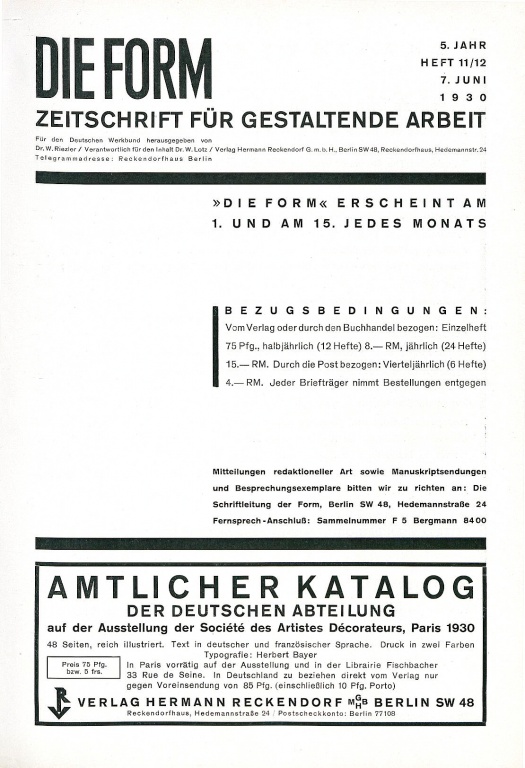

Die in den Jahren 1925-1934 erscheinende Zeitschrift „Die Form“ wurde von Walter Curt Behrendt für den Deutschen Werkbund herausgeben. Sie erschien im Berliner Verlag Hermann Reckendorf; ihre Auflage überschritt nie die Marke von 5.000 Exemplaren. Der Untertitel lautete von 1929 bis 1934 „Zeitschrift für gestaltende Arbeit“.
Bereits im Jahr 1922 hatte es einen ersten Versuch gegeben die Werkbund-Zeitschrift zu etablieren. So heißt es im Geleitwort des ersten Bandes (1925) von Walter Curt Behrendt „Mit dieser Zeitschrift setzt der Deutsche Werkbund ein Unternehmen fort, das bereits vor längerer Zeit begonnen, unter dem Druck der wirtschaftlichen Verhältnisse zunächst wieder aufgegeben werden mußte. Die Zeitschrift wird die Aufgaben der Formgestaltung für alle Gebiete des gewerblichen und künstlerischen Schaffens behandeln.“
Behrendt blieb bis Ende 1926 Herausgeber und wurde dann durch Walter Riezler abgelöst. Die Gestaltung der typographischen Umschläge lag in den Händen von Joost Schmidt. Er war seit 1919 am Bauhaus und leitete seit 1925 die Plastische Werkstatt. 1934/35 wurde die Zeitschrift von den Nationalsozialisten übernommen und dann eingestellt. (Source)
Publishers: Hermann Reckendorf, Munich and Berlin, 1922 & 1927-1932; Kurt Schroeder, Bonn and Berlin, 1925-1926; W. & S. Loewenthal, Berlin, 1933 (1-3); Wendt & Matthes, Berlin, 1933 (4-12), 1934 (1); Deutscher Werkbund, Berlin, 1934 (2-6); Walter de Gruyter, Berlin, 1935
via Universitätsbibliothek Heidelberg
Volumes (single PDFs) and separate articles (PDF, HTML):
Volume 1, 1922 (Die Form: Monatschrift für gestaltende Arbeit, 4 Issues)
Volume 1, 1925-1926 (15 Issues)
Volume 2, 1927 (Die Form: Monatschrift für gestaltende Arbeit, 12 Issues)
Volume 3, 1928 (Die Form: Monatschrift für gestaltende Arbeit, 15 Issues)
Volume 4, 1929 (24 Issues)
Volume 5, 1930 (24 Issues)
Volume 6, 1931 (12 Issues)
Volume 7, 1932 (12 Issues)
Volume 8, 1933 (12 Issues)
Volume 9, 1934 (6 Issues)
Volume 10, 1935 (1 Issue)
Oliver I.A. Botar: Prolegomena to the Study of Biomorphic Modernism: Biocentrism, László Moholy-Nagy’s “New Vision” and Ernő Kállai’s Bioromantik (1998)
Filed under thesis | Tags: · aesthetics, art history, avant-garde, biocentrism, biology, constructivism, modernism, nature, photography, science
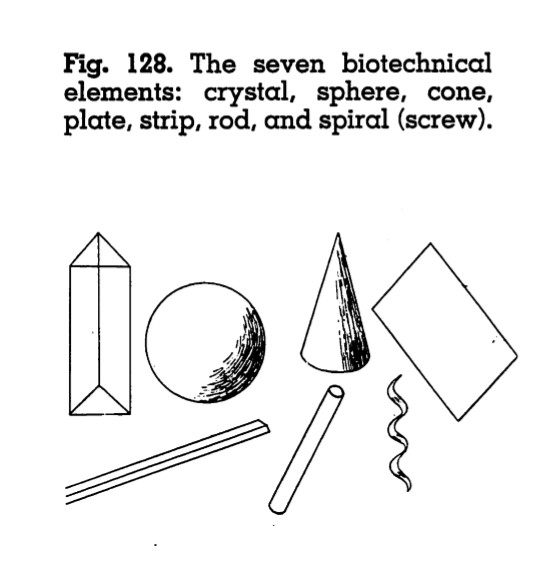
“Focusing on Weimar Germany, I ground the study of biomorphic Modernism in Ernő Kállai‘s 1932 identification of a trend he termed Bioromantik. Kállai wrote from a biocentric position, an amalgam of Nature Romanticism and biologism espoused by Nietzsche, Ernst Haeckel, Ludwig Klages, Oswald Spengler, Raoul Francé and Hans Prinzhorn in the early 20th century, here established as a politically-charged category of intellectual history. Kállai characterized Bioromantik as art, the imagery, forms or themes of which express Monist, Neo-Vitalist, lebensphilosophisch and Organicist, i.e. biocentric concepts such as the life-force, creative/destructive aspects of nature, and our unity with it. The work of artists he cited (Arp, Klee, Moore, Kandinsky, Ernst, etc. ) is biomorphic Modernist in style. Kállai’s conception derives from his realization of the similarity between biomorphic art and scientific photography, here termed the ‘naturamorphic analogy’, a topos traceable to Kandinsky’s pre-war writing.
Probably inspired by Walter Benjamin’s review of Karl Blossfeldt’s photographs, Kállai’s epiphany occurred in the Moholy-Nagy-curated ‘Raum-1’ of the 1929 Film und Foto show in Stuttgart; in effect a three-dimensional statement of his ‘New Vision’ that aestheticized scientific photography, and that — like Moholy’s entire pedagogical project — I show to be rooted in biocentrism. Thus, the profound effect biocentric thinkers had on the milieux Moholy emerged from is discussed: The fin-de-siècle Haeckelian tradition of normative aestheticized scientific imagery is shown to underlie New Vision; the biocentric wing of the Jugendbewegung is revealed as a source of Moholy’s biocentric pedagogy; inspired by Francé, ‘Biocentric Constructivism’ is identified as a discourse engaged in by Mies, Moholy, Lissitzky, Hausmann and Meyer; the Bauhaus, with attention to Gropius, Klee, Kandinsky, Schlemmer and Meyer, is recast as a locus of biocentric ideas.
Like others, Kállai proposed a ‘psychobiological’ explanation for the naturamorphic analogy: the artists’ identity with nature and their consequent intuitive imaging of its unseen aspects also revealed by science. I show how the aestheticization of scientific images effected by New Vision enabled Modernist artists and critics to be exposed to such imagery — an historical alternative to the essentialist explanation that constitutes a basis for research on biomorphic Modernist art.” (Abstract)
Department of the History of Art, University of Toronto, 1998
762 pages

